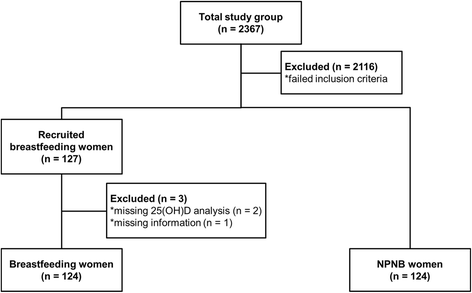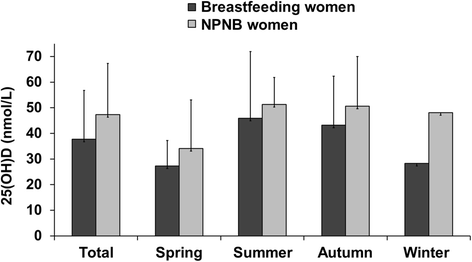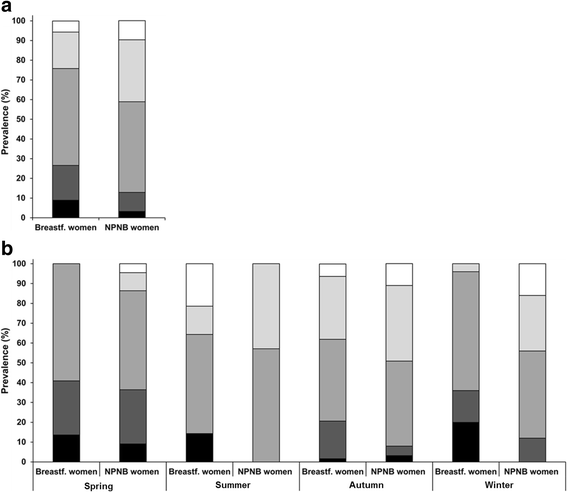Breastfeeding woman are at higher risk of vitamin D deficiency than non-breastfeeding women - insights from the German VitaMinFemin study
- PMID: 28435438
- PMCID: PMC5397784
- DOI: 10.1186/s13006-017-0105-1
Breastfeeding woman are at higher risk of vitamin D deficiency than non-breastfeeding women - insights from the German VitaMinFemin study
Abstract
Background: Despite increased awareness of the adverse health effects of vitamin D deficiency, only a few studies have evaluated the vitamin D status (25-hydroxyvitamin D [25(OHD)]) of breastfeeding women and up to now, no information exits for German breastfeeding women. Therefore, the aim of study was to determine the vitamin D status of breastfeeding women compared to non-pregnant and non-breastfeeding (NPNB) women.
Methods: This cross-sectional study investigated 124 breastfeeding women and 124 age and season matched NPNB women from the German "Vitamin and mineral status among German women" study. The study participants were recruited from April 2013 to March 2015 and did not take vitamin D supplements. Serum 25(OH)D was analyzed by chemiluminescent immunoassay.
Results: Vitamin D deficiency (<25.0 nmol/L) was prevalent in 26.6% of the breastfeeding women. The majority of women (49.2%) showed 25(OH)D concentration between 25.0 and 49.9 nmol/L. In multiple binary logistic regression analysis, breastfeeding women had a 4.0-fold higher odds ratio (OR) (95% confidence interval [CI] 1.8, 8.7) for vitamin D deficiency than NPNB women. For breastfeeding women, the risk of vitamin D deficiency was higher in the winter and spring months (OR: 2.6, 95% CI 1.1, 6.3) and increased with lower longitude per one unit (OR 0.7, 95% CI 0.6, 0.9).
Conclusion: Breastfeeding women in Germany had a higher risk of deficient vitamin D levels than NPNB women. In further studies, the optimal vitamin D status for breastfeeding women should be investigated and also the required vitamin D doses to ensure this vitamin D status.
Trial registration: German Clinical Trial Register (identification number: DRKS00004789).
Keywords: 25(OH)D; Breastfeeding period; Germany; Vitamin D.
Figures



 severe deficiency (<15.0 nmol/L),
severe deficiency (<15.0 nmol/L),  moderate deficiency (15.0–24.9 nmol/L),
moderate deficiency (15.0–24.9 nmol/L),  insufficiency (25.0–49.9 nmol/L),
insufficiency (25.0–49.9 nmol/L),  sufficiency (50.0–74.9 nmol/L) and
sufficiency (50.0–74.9 nmol/L) and optimal (75.0–124.9 nmol/L); Risk of excess (≥124.9 nmol/L) was not prevalent; (a) Breastfeeding women vs. NPNB women: p = 0.019*; (b) Between season in breastfeeding women: p <0.001*; Between season in NPNB women: p = 0.032*; Breastfeeding women vs. NPNB women in spring: p = 0.498*, summer: p = 0.070*, autumn: p = 0.139*, winter: p = 0.007*; 25(OH)D, 25-hydroxyvitamin D; Autumn, September – November; NPNB, non-pregnant and non-breastfeeding; Spring, March – May; Summer, June – August; Winter, December – February; *Chi-square test
optimal (75.0–124.9 nmol/L); Risk of excess (≥124.9 nmol/L) was not prevalent; (a) Breastfeeding women vs. NPNB women: p = 0.019*; (b) Between season in breastfeeding women: p <0.001*; Between season in NPNB women: p = 0.032*; Breastfeeding women vs. NPNB women in spring: p = 0.498*, summer: p = 0.070*, autumn: p = 0.139*, winter: p = 0.007*; 25(OH)D, 25-hydroxyvitamin D; Autumn, September – November; NPNB, non-pregnant and non-breastfeeding; Spring, March – May; Summer, June – August; Winter, December – February; *Chi-square testSimilar articles
-
Higher prevalence of vitamin D deficiency in German pregnant women compared to non-pregnant women.Arch Gynecol Obstet. 2017 Jul;296(1):43-51. doi: 10.1007/s00404-017-4398-5. Epub 2017 May 19. Arch Gynecol Obstet. 2017. PMID: 28526926
-
[The contribution of diet and sun exposure to the nutritional status of vitamin D in elderly Spanish women: the five countries study (OPTIFORD Project)].Nutr Hosp. 2008 Nov-Dec;23(6):567-76. Nutr Hosp. 2008. PMID: 19132265 Spanish.
-
[Vitamin D status in 6- to 10-year-old children: a French multicenter study in 326 children].Arch Pediatr. 2014 Oct;21(10):1106-14. doi: 10.1016/j.arcped.2014.04.012. Epub 2014 Jul 11. Arch Pediatr. 2014. PMID: 25028285 French.
-
High prevalence of vitamin D deficiency among women of child-bearing age in Lahore Pakistan, associating with lack of sun exposure and illiteracy.BMC Womens Health. 2015 Oct 12;15:83. doi: 10.1186/s12905-015-0242-x. BMC Womens Health. 2015. PMID: 26458880 Free PMC article.
-
Urgent action needed to improve vitamin D status among older people in England!Age Ageing. 2010 Jan;39(1):62-8. doi: 10.1093/ageing/afp195. Epub 2009 Nov 23. Age Ageing. 2010. PMID: 19934073
Cited by
-
Both Mother and Infant Require a Vitamin D Supplement to Ensure That Infants' Vitamin D Status Meets Current Guidelines.Nutrients. 2018 Mar 29;10(4):429. doi: 10.3390/nu10040429. Nutrients. 2018. PMID: 29596362 Free PMC article. Clinical Trial.
-
A Study to Identify the Most Common Reasons to Wean among Breastfeeding Mothers in UAE.J Pharm Bioallied Sci. 2020 Jan-Mar;12(1):72-76. doi: 10.4103/jpbs.JPBS_230_19. Epub 2020 Jan 29. J Pharm Bioallied Sci. 2020. PMID: 32801603 Free PMC article.
-
Immune Function and Micronutrient Requirements Change over the Life Course.Nutrients. 2018 Oct 17;10(10):1531. doi: 10.3390/nu10101531. Nutrients. 2018. PMID: 30336639 Free PMC article. Review.
-
Do Current Fortification and Supplementation Programs Assure Adequate Intake of Fat-Soluble Vitamins in Belgian Infants, Toddlers, Pregnant Women, and Lactating Women?Nutrients. 2018 Feb 16;10(2):223. doi: 10.3390/nu10020223. Nutrients. 2018. PMID: 29462926 Free PMC article.
-
A Prospective Evaluation of Serum Vitamin D (1, 25(OH)2 D3) and Endogenous Sex Hormone Levels in Colorectal Cancer Patients.Front Oncol. 2019 Jun 4;9:468. doi: 10.3389/fonc.2019.00468. eCollection 2019. Front Oncol. 2019. PMID: 31214508 Free PMC article.
References
LinkOut - more resources
Full Text Sources
Other Literature Sources
Miscellaneous

